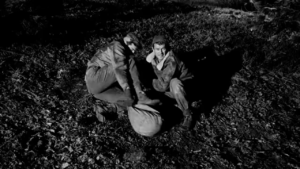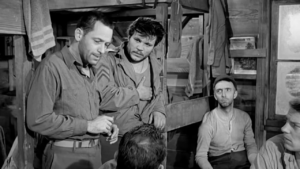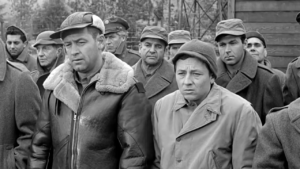Rating: 4.5 out of 5




![]()
According to the U.S. Navy and scholarly research, during World War II, it was estimated that 125-130,000 U.S. Army personnel were captured by the enemy. Nazi Germany had over 1000 prisoner-of-war camps during the war. Out of these camps, two primary types were established. The first was Oflags, which was called “Officer camp,” and the other was Stalags, which was called “Base camp.” Stalags were for individuals who were enlisted and non-commissioned personnel. Based on some agreement, these personnel were of lower ranks and were used to work in agriculture and other minor fields but were not allowed to work in any industry producing war materials. Starvation was a deliberate and extreme policy in the Stalags, especially towards Soviet prisoners of war. The camps consisted of a field surrounded by barbed wire and lookout posts. Thousands upon thousands of prisoners were stuffed into these camps where space was minimal. Food was limited, with only enough to keep prisoners alive. In Soviet Stalags, it was estimated that the death rate was around 58%. If you compare that to the other Western Allies, it was as low as 5%. Germany had some major hatred for the Soviets.

A few movies and shows have been set in stalags, such as Hogan’s Heroes, Hart’s War, and The Great Escape. I recently watched Stalag 17, a film directed by Billy Wilder that was adapted from the Broadway play of the same name. Shout out to Donald Bevan and Edmund Trzcinski, who wrote the play after their own experiences as prisoners in Stalag 17B in Austria. The story is about a group of American airmen confined in Stalag 16 with over 40,000 prisoners, along with one compound holding 630 American sergeants. The film focuses on one barracks where the men think that one of their own is a snitch.
The film starts in December 1944 with the men in Barracks 4. Barracks 4 is led by barracks chief “Hoffy” Hoffman and security officer Frank Price. These two men aim to escape the hell hole of the Stalag. They arrange for fellow airmen Manfredi and Johnson to escape. During the escape attempt, Manfredi and Johnson are brutally gunned down. This raises suspicion in the barracks that they might have a snitch. The barracks believe that the snitch is none other than J. J. Sefton. Sefton makes no secret nor hides that he openly barters with the German guards to get luxury goods. Sefton also has various profitable ventures to help distract the men from their harsh reality, such as having rat races, brewing alcohol, and making a telescope to spy on Russian women from the neighboring compound. Sefton is a hustler, and the man is trying to survive. Don’t hate the player; hate the game.
Even though this is a war film, the film and Wilder’s direction show some of the comedic side to show how the men keep from losing their minds. This is due to the antics of barracks knuckleheads “Animal” Kuzawa and Harry Shapiro. These two men are always up to no good, and you wonder how they haven’t been shot yet. They paint a white strip on the ground to get close to the women’s barracks, only to be pushed away. Another scene is when the group dresses up as Hitler, gives rousing speeches, and when the commander walks in, looks at everyone, and says one Fuhrer is bad enough.

What Wilder does next is add a little dynamite to the overall situation and make for tension and despair in this who is the snitch film. Things change in the barracks when recently captured Lieutenant Dunbar is assigned to Barracks 4. He was supposed to be put in the offers camp, but that camp is a little cramped. Sgt. Bagradian accompanies Dunbar and lets it slip that Dunbar rigged a time bomb in transit and blew up a munitions train. Sefton recognizes Dunbar from their time in officers’ school and has some hate against him, believing he only made it through camp because of his wealthy family. This causes major tension among them. Tensions continue to rise when Sefton makes a deal to spend a day with the Russian women. When the barracks radio is revealed and confiscated, the men immediately blame Sefton and brutally beat his ass.
Without ruining the ending, things get crazy on Christmas Eve, but I guarantee that you will be invested in learning who the snitch really is. The way Wilder sets up the entire thing and how it ends will draw you in and keep your attention. Need to watch out for those snitches because they will get you killed. The film’s ending was what you wanted and should applaud because of everything the men worked for; the ending gives you a little hope that they can succeed and bring in the troops to liberate the camp.
As stated earlier, I want to give major props to Billy Wilder for the direction of this film. I would say that it is difficult to convert a Broadway play into a two-hour film, but Wilder manages to do it. He did an excellent job of showing the barracks and the men in it doing rat races, showing the tension between characters, and having comedic elements. Wilder needs and should be given major props for pulling this off.

As far as the cast goes, the two that stand out the most are William Holden as J.J. Sefton and Robert Strauss as Stanislas “Animal” Kuzawa. Holden won the Academy Award for his performance. When you are the one everyone has a side-eye against you, and you take an ass whipping, you are winning the award. Holden was perfect in his role. I want to also give props to Strauss as Kuzawa. He was honestly the best part of the entire film because he was so funny. The scene where he is dancing with a fellow prisoner and then starts crying because the prisoner isn’t a woman is hilarious, and it is all due to Kuzawa’s performance.
Stalag 17 is a great film based on the writers’ experiences during their imprisonment in a Stalag. Wilder was outstanding with his direction and putting the tension in the barracks. Holden and Strauss were great in their respective roles. Watch this film and get a small taste of what life was like in a Stalag.